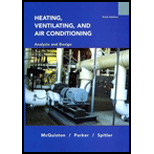
Concept explainers
Using Fig. 4-1, draw a conclusion about the comfort of a mixed group of men and women in typical seasonal clothing, with sedentary activity for the following cases:
a. Summer, operative temperature 77 F, wb 64 F
b. Winter, operative temperature. 77 F, wb 64 F
c. Summer, operative temperature 75 F, dp 50 F
d. Winter, operative temperature 73 F, dp 34 F
(a)
The comfort of mixed group of men and women in typical seasonal clothing.
Answer to Problem 4.1P
According to given condition, the group will feel comfortable.
Explanation of Solution
Given:
The operating temperature of summer is
The wet bulb temperature of summer is
Calculation:
From fig4-1,
According to ASHRAE standard, the acceptable range of operating temperature is
(b)
The comfort of mixed group of men and women in typical seasonal clothing.
Answer to Problem 4.1P
According to given condition, the group will not feel comfortable.
Explanation of Solution
Given:
The operative temperature of winter is
The wet bulb temperature of winter is
Calculation:
From fig4-1,
According to ASHRAE standard, the acceptable range of operating temperature is
(c)
The comfort of mixed group of men and women in typical seasonal clothing.
Answer to Problem 4.1P
According to given condition, the group will feel comfortable
Explanation of Solution
Given:
The operative temperature of summer is
The dew temperature of summer is
Calculation:
From fig4-1,
According to ASHRAE standard, the acceptable range of operating temperature is
(d)
The comfort of mixed group of men and women in typical seasonal clothing.
Answer to Problem 4.1P
According to given condition, the group will feel uncomfortable.
Explanation of Solution
Given:
The operative temperature of winter is
The dew temperature of winter is
Calculation:
From fig4-1,
According to ASHRAE standard, the acceptable range of operating temperature is
Want to see more full solutions like this?
Chapter 4 Solutions
Heating Ventilating and Air Conditioning: Analysis and Design
Additional Engineering Textbook Solutions
Concepts Of Programming Languages
Database Concepts (8th Edition)
Electric Circuits. (11th Edition)
Degarmo's Materials And Processes In Manufacturing
Starting Out with Programming Logic and Design (5th Edition) (What's New in Computer Science)
Starting Out with Java: From Control Structures through Data Structures (4th Edition) (What's New in Computer Science)
- Oxygen (molar mass 32 kg/kmol) expands reversibly in a cylinder behind a piston at a constant pressure of 3 bar. The volume initially is 0.01 m3 and finally is 0.03 m3; the initial temperature is 17°C. Calculate the work input and the heat supplied during the expansion. Assume oxygen to be an ideal gas and take cp = 0.917 kJ/kg K. For 1 bonus mark explain why (using your understanding of thermodynamics) that oxygen is used in this context rather than water vapour.arrow_forwardHydrodynamic Lubrication Theory Q1: Convert this equations into Python by 1- ah ap a h³ ap 1..ah = ax 12μ ax ay 12μ ay 2 ax Where P=P(x, y) is the oil film pressure. 2- 3μU (L² ε sin P= C²R (1+ cos 0)³ Q2: prove that |h(0) = C(1+ cos 0) ?arrow_forward### To make a conclusion for a report of an experiment on rockets, in which the openrocket software was used for the construction and modeling of two rockets: one one-stage and one two-stage. First rocket (single-stage) reached a maximum vertical speed of 200 m/s and a maximum height of 1000 m The second rocket (two-stage) reached a maximum vertical speed of 250 m/s and a maximum height of 1800 m To make a simplified conclusion, taking into account the efficiency of the software in the study of rocketsarrow_forward
- What is the difference between saturated liquid and compressed liquid? What is the difference between the critical point and the triple pointarrow_forwardWhat is quality? Does it have any meaning in the superheated vapour region? What is the difference between saturated vapor and superheated vapour? What is the difference between saturated liquid and compressed liquid? What is the difference between the critical point and the triple point?arrow_forwardHomework#5arrow_forward
- Describe the principle operation of PEMFC, and role of membrane electrode assembly (MEA).arrow_forwardHomework#5arrow_forwardUsing graphical methods, draw the pressure angle at the position shown in (a) and (b). e |------- R = Cam Base Radius e = Follower Offset ẞ₁ = Section Duration 1 B₁ = Section Duration 2 ẞ₂ = Section Duration 3 В2 B₁ Follower Position ww R ẞ3 (a) Reference Radial (b)arrow_forward
- The figure below illustrates a graph that has a variable load torque and constant drive torque. Each cycle lasts three revolutions (6л radians). Torque (N-m) 600 550 400 1 200 TD= 225 N-m 2 + -T₁ 3 4 1 + 0 In addition, the rotation speed is @o steady-state conditions, determine 1. the average power required, 2πT 4π 5πT 6п Ꮎ = 180° rpm = 18.85 rad/sec, Imachine 125 kg-m². Assuming 2. the maximum and minimum rotational speeds throughout a cycle, 3. the mass of a 0.6-meter-diameter solid disc flywheel to produce Cs = 0.025.arrow_forwardAn elastic cord is stretched between 2 points A and B located 2y = 0.8 m apart in the horizontal plane. When stretched directly between A and B, the tension is P₂ = 40 N. The cord is then stretched as shown until its midpoint C has moved through x = 0.3 m to C', and a force of F = 240 N is required to hold the cord at C'. A pellet (m = 0.1 kg) is placed at C' and the cord is released. Find the speed of the pellet as it passes through C.arrow_forwardA 6305 ball bearing is subjected to a steady 5000-N radial load and a 2000-N thrust load and uses a very clean lubricant throughout its life. If the inner race angular velocity is 500rpm find (a) The equivalent radial load (b) The L10 life (c) The L50 lifearrow_forward
 Principles of Heat Transfer (Activate Learning wi...Mechanical EngineeringISBN:9781305387102Author:Kreith, Frank; Manglik, Raj M.Publisher:Cengage Learning
Principles of Heat Transfer (Activate Learning wi...Mechanical EngineeringISBN:9781305387102Author:Kreith, Frank; Manglik, Raj M.Publisher:Cengage Learning
